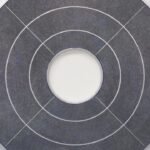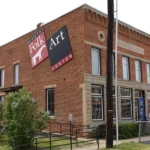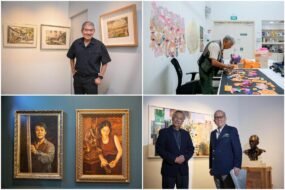
Their love story with corrugated iron brought them together. For new, old and rusty pieces of metal, Marina Burnel flew over 12,000 kilometres from Jamaica to meet Adam Masave in Nairobi who uses corrugated iron as his art medium.
Adam and Marina are hosting a joint exhibition dubbed Ah Suh it Guh at the Alliance Francaise, Nairobi.
Ah suh it guh is a patois phrase that translates to c’est la vie (such is life) in French. It has been featured in many songs including by Jamaican artistes Gyptian and Lutan Fyah.
So how did they meet? From Instagram, Marina, 51, reached out to Adam after seeing his metal artwork.
This exhibition marries life in Jamaica and Kenya so effortlessly.
“The way this exhibition came to be, is I was invited by the Alliance Françoise for two weeks, first in Mombasa to show young people street photography and they then asked, ‘why don’t you exhibit some of your works from Jamaica in Nairobi,” Marina who came up with the Ah Suh it Guh theme tells the BDlife.
“I said it would be nice to be paired with a Kenyan artiste and coincidentally about three years ago, through social media I came upon Adam’s page and as someone who works on street photography on corrugated iron, I loved his work,” she adds.
This show captures the similarities of the daily lives of Jamaicans and Kenyans.
Jamaica’s downtown which is plagued with gangs, drugs and violence is also highlighted in the exhibition.
The scenes are similar to different slums around Nairobi and in particular Mukuru where Adam is using art to rehabilitate the youth.
Adam’s work shows the hustle and bustle of men and women from the slums including a woman who was heavily battered but made her way to market to sell groceries. There is also a keg delivery guy and a chicken seller on the brink of eviction.
The battered woman painting was bought for Sh270,000, and part of the money will go into supporting the gender-based violence victim.
“The keg delivery is someone I know from Mukuru slums. He used to carry stuff on his shoulders but saved some money and bought a motorcycle which he now uses. We recently met and he told me he wants to save up and get a truck. Some of my work shows the positive side of slum,” says Adam.
“I use corrugated iron to bring something original to be a backdrop for the story. Our theme is joined by the corrugated iron, and the fact that Marina lives in Jamaica where their struggles and lifestyles are similar to Kenya,” says Adam.
Adam has showcased his artworks depicting the recent youth-led street protests. He exhibited in different parts of Europe.
“Some of my work [Gen Z march and Statehouse march] talk about the GenZ protest. These young people achieved a lot. At the time I had travelled to Europe and everywhere I went people were congratulating me saying Kenya is a good example of democracy,” says Adam.
He adds, “Although people can forget about what happened, art is one way to immortalise this piece of our history.”
Marina says that although there has not been much uproar lately, Jamaica is a country that suffers from violence and poor living conditions as shown in an artwork called “Trigger and Guidance and Protection.”

Adam Masava’s ‘Gen Z protest’ at the Alliance Française during the Ah Suh it Guh exhibition on October 4, 2024.
Photo credit: Edna Mwenda| Nation Media Group
With a mix of prints transferred on canvas or iron, Marina brings to life the street life of Jamaica and her time in Mombasa and Nairobi.
“When I moved to Jamaica 10 years ago, these were the first youth I met and I have worked with them in street photography,” she says.
She tells the BDLife that after seeing what Adam had painted on corrugated iron for the exhibition, she took to the streets and took a few photographs which she later transferred on the metal.
Adam says the exhibition depicts family life in a city, from the children playing which represents hope to the grandmother and mother in a market, which shows ambition and drive.
He narrates the story behind the door marked X, one of his paintings at the Alliance Francaise exhibition.
“I know this guy (pointing to the X door painting), he sells chicken but has been struggling to pay rent, which is a big issue around the world.”
He continues,“The man lived in a house that had many power lines above the roof, which was a hazard to him and the people around and that’s why the door was marked X ready for eviction. He once asked me to find someone to help him move out,” says Adam.
“So I visited him to understand his plight and as we were talking his son came home after school and on seeing me, he immediately burst into tears which shocked me. He thought I was one of the government officers who had come to evict them.”
Adam thought of painting the man living in the door marked X and selling the artwork to help him generate some money.
“I later invited the boy to see his dad’s portrait at my studio and asked him, “what message would you like to send the government?” He responded, ‘please do not demolish our house’ which I asked him to write on the piece and finish the painting.”











